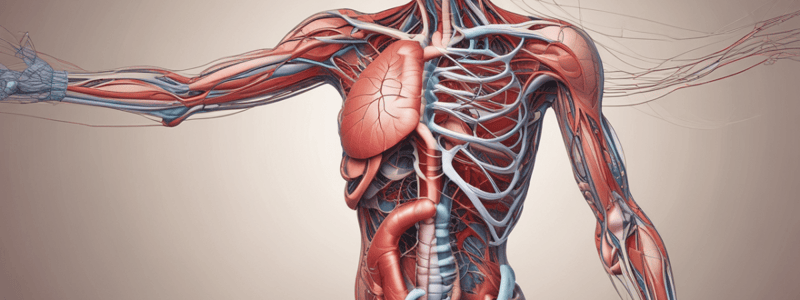Podcast
Questions and Answers
What is the approximate number of times the heart beats in a lifetime?
What is the approximate number of times the heart beats in a lifetime?
- 2.5 billion (correct)
- 1 billion
- 10 billion
- 5 billion
What is the function of the valves in the heart?
What is the function of the valves in the heart?
- To control the flow of blood from one chamber to another (correct)
- To filter the blood
- To pump blood through the heart
- To mix oxygen-rich and oxygen-poor blood
What is the direction of blood flow through the heart valves?
What is the direction of blood flow through the heart valves?
- In both directions
- Only in one direction (correct)
- Randomly
- None of the above
Where does oxygen-poor blood from the body flow into?
Where does oxygen-poor blood from the body flow into?
What is the sound produced by the heart valves opening and closing?
What is the sound produced by the heart valves opening and closing?
Where does the oxygen-poor blood return to after being used by the body?
Where does the oxygen-poor blood return to after being used by the body?
What is the function of the valve in the heart that the blood passes through after picking up oxygen from the lungs?
What is the function of the valve in the heart that the blood passes through after picking up oxygen from the lungs?
What does the phrase 'Be Ready to Read Long Love Letters' help you remember?
What does the phrase 'Be Ready to Read Long Love Letters' help you remember?
What happens to the blood after it passes through the left ventricle?
What happens to the blood after it passes through the left ventricle?
Where does the blood initially pick up oxygen from?
Where does the blood initially pick up oxygen from?
Flashcards are hidden until you start studying
Study Notes
Heart Structure
- The heart is approximately the size of a fist and beats around 2.5 billion times in a lifetime.
- It is composed of several smaller parts, including chambers and valves, which work together to pump blood.
Chambers
- The heart has four chambers, similar to rooms in a house, with two chambers sitting atop the other two.
- The upper chambers are the atria, and the bottom chambers are the ventricles.
- There is a right atrium and ventricle, as well as a left atrium and ventricle.
Valves
- The chambers are separated by valves, which control the flow of blood from one chamber to another and to the rest of the body.
- Valves open and close, making a noise similar to 'lub-DUB', which is the sound of the heartbeat.
- Heart valves only open in one direction, directing the flow of blood through the heart.
Function and One-Way Blood Flow
- Blood has two forms: oxygen-poor and oxygen-rich.
- Oxygen-poor blood from the body flows into the right atrium, then passes through a valve into the right ventricle.
- The right ventricle pumps the blood through another valve to the lungs, where it picks up oxygen.
- The oxygen-rich blood returns to the left atrium, then passes through another valve to the left ventricle.
- The left ventricle pumps the oxygen-rich blood out to the rest of the body.
- The cycle starts again with the oxygen-poor blood returning to the heart.
- A helpful way to remember the blood flow cycle is with the phrase 'Be Ready to Read Long Love Letters', which represents the sequence: Body, Right atrium, Right ventricle, Lungs, Left atrium, Left ventricle, and back to the Body.
Studying That Suits You
Use AI to generate personalized quizzes and flashcards to suit your learning preferences.




